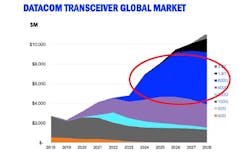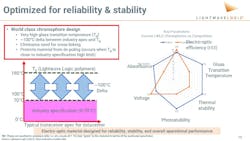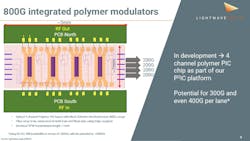Would Archimedes say ‘Eureka!’ if he saw AI and an electro-optic polymer platform?
Archimedes, a revered Greek mathematician, is credited with several mathematical inventions, including pi, spirals, exponents for large numbers, hydrostatics, levers, and gravity. His famous quote aligns with his discovery of the volume of an irregular shape from the water displacement in his bathtub—after which he took to the streets, unclothed, shouting “Eureka!”
During the two millennia that ensued, many surprising inventions, discoveries, and innovations may have been worthy of the comment of “Eureka!.” Today, we question whether the rise of AI, and its impact on the internet and optical networking, is also worthy of being called a Eureka! moment. And can a new associated technology platform using electro-optic polymers help AI accelerate on the internet?
Gauging the impact of AI
We’re only 20 years beyond using dial-up modems that used to take, on average, 10 to 20 minutes to download a single image. Only 10 years ago, we could wait 10 to 20 minutes to download a short video clip or TV show. As wait times shortened, image and video notoriously became the largest generators of internet traffic. Within the past year, it became apparent that AI or raw computational power will drive even higher traffic levels on the internet.
For example, in 2003, Netflix reached a milestone of one million subscribers, roughly 3.5 years after it launched its streaming video service. This year, ChatGPT gained one million users within five days, and Threads by Meta is rumored to have attracted close to 100 million users within a little more than a week. This massive emergence of AI is set to impact society in ways we can’t imagine.
Beyond this, the growth of computing power in high computational processing systems during the past 60 years has initially doubled every three to five years.1 Since about 2020, the growth has increased by more than an order of magnitude, or 10x, to a doubling of computational power every three to four months (in terms of petaflops, which is a metric for computational processing magnitude).2 This increase in computational processing using graphical processor units (GPUs) and microprocessing units (MPUs) is driven for the most part by neural networks that compose AI. This growth places increased strain on the infrastructure supporting computational processing.
The capacity for optical signal information traveling down fibers must be increased—and the places where the optical routing and switching takes place, typically data centers, are clearly needed to deal with higher amounts of information. The economic cost for the internet and optical network operators will be more expensive.
AI and the internet
AI is integrating deeper into our daily activities with applications to make us more efficient and, possibly, smarter. It would be stupid of us to not consider the consequences as these tools proliferate and introduce machine intelligence to everyday people. The impact on the internet is huge, and the internet is based on an optical network that uses data centers to route and switch traffic or information to and from destinations.
Data centers are being upgraded today in ways the industry has not seen before. The expected demands of increased traffic, information, and data driven by AI are changing the way the internet is operated.
AI is now creating new and interesting market opportunities to upgrade the internet, and three of these are hotly debated today: density, speed, and low power. These three markets are driving engineers to design higher-performance optical and photonic components that are supported by the fiber optic cables that interconnect data centers as part of the internet infrastructure.
Optical components today must address higher switch density from smaller size or footprint, higher and faster optical information flow from the increased electronic computation processing, and the need for green, low power consumption. One new flavor of upcoming optical components to support these three market areas includes devices such as polymer modulators that are physically positioned in front of lasers that send light into the fiber-optic cables.
Electro-optic polymer modulators
A new polymer material for an optical component, called a modulator, is being developed to replace existing semiconductor modulators used in today’s internet. An optical modulator switches and modulates light, and there are millions of these devices on the internet or optical network architecture today. The current semiconductor incumbent solutions are struggling to deal with higher data rates, higher traffic volumes, low power requirements, and the small sizes necessary to cope with the rising popularity of AI.
Lightwave Logic sources and creates state-of-the-art organic materials called Perkinamine electro-optic polymers. We start with our own proprietary-designed organic chromophores, which are a key ingredient of polymer, and they get deposited onto a silicon chip to add an optical modulator function.
During the fabrication of these modulators, a high voltage is applied to them briefly to align the chromophores so that ultrafast modulation, at ultralow power is enabled. Our polymer materials, and the integrated photonic silicon circuits (otherwise known as photonic integrated circuits [PICs]) that are applied to them to are reliable and stable in performance, which positions them to displace incumbent semiconductor technologies.
Polymer modulator devices are formed on a silicon-based chip roughly a few millimeters on each side, where the Perkinamine chromophore electro-optic polymer is deposited. These chips represent the engine of a fiber optic transceiver, which is a key component for data center switches and routers.
One way to visualize a high-performance optical engine is to think about automotive vehicles. Polymer modulators represent upgrading, for example, a four-cylinder engine to a V8 engine while keeping the whole network infrastructure the same. By turbocharging the fiber-optic modules, the other parts of the data center infrastructure remain in place. These fiber-optic modules go into large metallic racks that are typically 6- to 8-feet high and about 2-feet wide, and 2-feet deep. There are hundreds of these racks inside datacenters today. Each one of these racks make up the datacenter system architecture and can include routers, switches, and memory units.
Overall, one way to look at electro-optic polymer technology is that it is solving a huge problem for the internet and optical networking—not just for today’s generation of products but for perhaps more than a decade.
Electro-optic polymers have an inherent natural high-performance advantage due to velocity/phase matching of the electrical signal and the optical beam, which allows them to have the potential to extend out in higher performance for future-generation products. While there are other competitive technologies that are both incumbent as well as competing for new business within the optical modulator space, these technologies unfortunately may not work well after this generation of technology matures. Technology with performance headroom for several generations is something that internet and optical network architecture needs for continual upgrading.
To visualize this performance potential, look at the same baseline in every optical modulator: 3- dB optical bandwidth. Each optical modulator, whether silicon, indium phosphide, lithium niobate etc., has a basic optical 3-dB bandwidth. For the past decade, the incumbent semiconductor optical modulators were achieving roughly 20 to 30 GHz in the optical 3-dB bandwidth.
More recently, both silicon and indium phosphide increased their designs to increase their basic bandwidth performance to 40 to 60 GHz, with sporadic performances approaching 70 GHz. As a rule of thumb, a 70-GHz 3-dB optical bandwidth is needed for 100 Gbit/s (or 100 Gbaud NRZ) and 200 Gbit/s (or 100 Gbaud PAM4) encoding.
In today’s optical networks, many data center operators are looking for technologies that are capable of at least 200 Gbit/s per lane (for 800 Gbit/s 4 lanes, and 1.6 Tbit/s 8 lanes). Polymer modulators easily achieve 70 GHz and have shown performance levels already at 150 GHz (which is roughly double today’s lane rate, which enables the potential of 1.6 Tbit/s with 4 lanes).
Further, if plasmonic designs are incorporated into polymer modulator device designs, 3 dB bandwidths in excess of 250 GHz have already been demonstrated using Lightwave Logic’s electro-optic polymer material. This has the potential for information lane rates nearly quadruple today’s goal.
Polymer modulators are a new enabling platform technology for AI
A significant headroom in performance that can be shown by polymer modulators is exactly what data center architects are looking for when designing next-generation optical networking equipment such as fiber-optic transceivers.
A new technology platform that can turbo-boost existing transceivers without changing the network architecture and infrastructure is a low-cost approach to speed up the internet. By providing higher-performance optical components, the internet is in a better and stronger position to absorb the wave of data, information, and traffic. As AI rises in popularity, the demand for ever-increasing performance in optical components will increase. Lightwave Logic’s polymer technology shows potential to enable higher-performance fiber-optic modules and subsequent optical networking equipment.
‘Eureka’ or not?
To address the original question of this article: Would Archimedes consider the rise of AI to be a “Eureka!” moment? Whatever the answer, I very much doubt he would run down the street unclothed. Perhaps instead, he would sip an Americano from the local coffee shop while surfing the internet, using AI applications available to everyone today.
I believe this is a Eureka moment for AI because the potential impact could change the quality of our lives. We need to just imagine the new ideas and inventions Archimedes could have achieved with the AI tools we have today.
Given the incredible potential electro-optic polymers offer, Archimedes may view this new technological platform as heading quickly toward a “Eureka!” moment. The impact of electro-optic polymers will become clear fairly soon.
REFERENCES
1. S. J. Ben Yoo, arXiv:2209.08873v1 [cs.NI] (Sep. 2022); https://doi.org/10.48550/arxiv.2209.08873.
2. E. Masanet, A. Shehabi, N. Lei, S. Smith, and J. Koomey, Science, 367, 6481, 984–986 (Feb. 28, 2020); doi:10.1126/science.aba3758.



